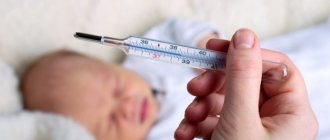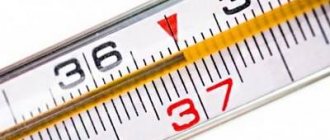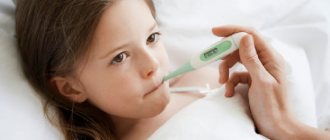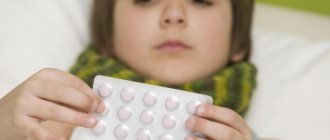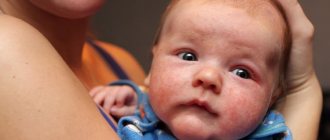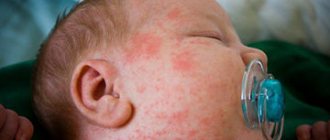An allergy is a reaction of the immune system to a particular allergen. Most often, children are susceptible to it, since some food products, entering their bodies, are perceived as a foreign element. This occurs as a result of imperfect functioning of the gastrointestinal tract and immune system.
Thus, the child’s body begins to fight this element with all possible methods. This is where skin irritation, rashes and redness, itching, sneezing and nasal congestion appear. But today we want to discuss the topic of elevated temperature due to allergies. Is such a symptom possible in this situation and how to deal with it correctly, let’s look further.
Do children have fever due to allergies?
Unfortunately, no specialist can give an exact answer to this question. Since, on the one hand, some experts argue that an elevated mark on the thermometer is the result of an inflammatory process that began in the body and with which the latter is fighting. That is why the important point is to diagnose this process and prescribe correct and adequate treatment, which will help stabilize the situation as quickly as possible.
However, there are other experts who argue that this state of affairs is a completely normal phenomenon, since the process of developing allergies in our body is accompanied by the release of a large amount of histamines. It is this biologically active substance that performs many functions for our life. One of them is the dilation of peripheral vessels and an increase in their permeability. In turn, this process entails an increase in the concentration of histamine in a particular area of the skin or organ. However, it is also worth noting: in order for histamine to affect not a single area of the skin, but all processes, and thereby cause an increased mark on the thermometer, it must be produced in such an amount that a serious danger may arise for a person’s health.
So let's recap. An increase in temperature due to an allergic reaction is possible, although this is a very rare occurrence . If you observe a similar symptom in a child, you should immediately contact a specialist, as it may be accompanied by other dangerous complications, such as anaphylactic shock.
But so as not to scare you, it is worth noting that most often an elevated temperature is not the result of the allergy itself, but the effect of a fungal or viral infection in the body. In addition, a high reading on the thermometer may also be a sign of intoxication. And toxins are also strong allergens.
How to distinguish allergies from colds:
The symptoms of allergies are not much different from the symptoms of a cold. In both cases, a runny nose, nasal congestion, lacrimation, and cough may occur. The presence of an elevated temperature indicates, rather, a viral disease. But, as we have already found out, it can also occur with allergies. To correctly determine the nature of temperature, you need to pay attention to the following factors:
- nasal discharge - with allergies it is liquid and transparent, as they say, “water” from the nose, but with a virus it is thick and yellowish;
- well-being - with a cold, it worsens gradually: at first there may be a sore throat, slight malaise, then a runny nose, cough and fever appear. And allergy symptoms can appear suddenly, over a short period of time;
- itching of the nose, eyes, paroxysmal sneezing, rash on the body are clear signs of an allergic reaction;
- a feeling of weakness, muscle pain - can only occur with a cold;
- contact with an allergen - parents themselves can analyze and understand the cause of the child’s illness if he had contact with a certain irritant;
- similarity of symptoms, but different intensity : cough - often occurs with a cold, and rarely with allergies; redness of the eyes - rarely with a cold, often with allergies.
In case of a rapid and sudden increase in temperature due to allergies, anaphylactic shock may develop. You should consult a doctor or call an ambulance as soon as possible.
It is possible that an allergy may occur with vague symptoms, especially in the first stages of its development. Even experienced allergy sufferers often cannot accurately determine whether these are the first signs of a virus or the onset of an allergy.
Types of allergies that most often cause fever in children
A reaction of this kind is most often observed in certain life situations and under the influence of certain factors. Let's take a more specific look at the cases in which an increase in temperature can be observed.
Allergy to bites
The moment any insect (wasp, bee, ant, or, especially, snake) injects its poison, a toxic effect occurs on the body. And when this toxin enters the bloodstream, the human body reacts by raising the mark on the thermometer, sometimes even to a significant level, for example, 39°. Thus, it performs a protective function and reacts to the appearance of poisons in it.
In addition, an allergy of this kind may be accompanied by swelling, up to the development of Quincke's edema, a drop or increase in blood pressure, rash and itching at the site of the bite. This form of it is quite difficult and requires prompt assistance from medical staff.
Medicinal
Many medications can cause an allergic reaction. In addition to the possible complications prescribed in the instructions in the form of a rash, nausea, vomiting, an increase in temperature may also be observed. It is absolutely not important what method of taking the drug was, whether it was an injection, or the form of tablets or capsules. This reaction is especially common to penicillin antibiotics.
Administration of vaccines (serum allergy)
A rise in the thermometer mark above normal, as a symptom after the administration of a vaccine, is very rare. But if such a symptom occurs, then we can say that in this way the body recognizes the virus and learns to fight it. In this case, this symptom will go away on its own within 1-2 days.
And if, in addition to it, you also observe hives, itching, pain in joints and muscles, disturbances in the functioning of internal systems, then this is a reason to immediately call emergency help.
What to do, how to treat?
As already mentioned, the temperature during allergies does not rise above 38 degrees, so it is not recommended to bring it down with medications. Drinking plenty of fluids and rest will be enough.
But regardless of what causes the increase in temperature, consultation with a doctor is necessary. Of course, before he arrives, we can and must provide first aid to the child:
- stop or minimize contact with the allergen;
- give the child an antihistamine (Tavegil, Fenkarol, Diazolin, etc.);
- if there have been insect bites, thoroughly rinse the bite site and lubricate it with anti-inflammatory or antiallergic ointment (Fenistil, Claritin). This will reduce the allergic reaction of the skin and alleviate the condition;
- use enterosorbents and drink more water to remove toxins from the body;
- If you are allergic to medications, temporarily stop using them until you consult a doctor.
Allergies should be treated at the first sign of its manifestation. If this is not done, it will spread further every day and can cause the development of other serious diseases. Parents with a child with allergies are advised to always have antihistamines on hand, because once an allergy occurs, it can return again at any time.
Symptoms. Diagnostics
If the fever is the result of an allergic reaction, it will be accompanied by additional symptoms: sneezing, nasal congestion, watery eyes, swelling of the face or limbs, rash, itching.
An allergist, pediatrician or therapist can diagnose exactly what is causing this condition: an infectious disease or an allergy. In addition, additional evaluation by a gastroenterologist, otolaryngologist, and infectious disease specialist is sometimes required.
To study the situation, the patient must be examined and the parents interviewed to find out what could have caused the reaction. If necessary, additional studies and tests are prescribed. In order to find out which allergen is incompatible with the child’s body, one of the existing research methods can be carried out: a test that is carried out with the direct participation of a person, or a non-contact one.
The first group includes the skin test method. In this case, the allergen is applied to an area of the body - the inside of the elbow or the back, and the child’s condition is monitored. This method is quite cheap. But it has a number of health restrictions that are taken into account during the procedure. It is not done at the time of exacerbation of allergies or a chronic disease, after recent use of hormonal drugs, in severe health conditions, or in cases where the baby has become infected with a viral disease.
Another method involves taking blood from the patient and testing it in a laboratory. This method is similar to a simple blood test, but is much more expensive. The advantage is that you should not overtire the baby within the walls of the hospital. There are no special health restrictions for its implementation. In addition, you will be able to identify both the main allergens and additional ones, and be aware of their presence in the future.
It is worth noting that when determining the cause of a reaction or disease, the doctor may prescribe additional tests in the form of ultrasound, x-rays, etc.
Food irritants
Food allergies, as a negative reaction to a certain product, occur more often in young children than in adults. This reaction occurs every time an allergen is consumed. The most vulnerable age group is under 4 years old .
Food irritants in most cases are:
A high temperature, as a result of an allergy, is observed soon after eating (less often, a few hours or later). In isolated cases, even the sight or smell of such food causes a response from the body.
In this case, swelling and itching of the face and throat first appear, and then diarrhea, abdominal pain, urticaria, eczema and skin flushing.
Manifestations of rhinitis with cough, runny nose and rapid breathing are no exception.
The temperature can rise to a critical level of 40 degrees.
The extreme manifestation of an allergic reaction to food is anaphylactic shock with a sharp decrease in blood pressure and loss of consciousness.
Fortunately, food allergies
affect only 3% of young children and most often go away on their own once they reach three years of age.
Parents, playing it safe, often unreasonably deprive their children of certain products, considering them to be the culprits of allergic manifestations in children.
It is the prerogative of a specialist to make such conclusions..
Excluding entire groups of foods from a baby’s diet can lead to vitamin deficiency and weakening , and then various severe infectious diseases with elevated temperature cannot be avoided.
Food allergies with high fever are often observed in children with aggravated heredity, i.e. if such cases have previously occurred in the family.
In case of severe allergic reactions that occur repeatedly in close relatives, you should seek help from a doctor even during the pregnancy of the expectant mother.
Treatment of fever during an allergic reaction in children
Under no circumstances should you start treatment on your own without consulting a doctor. Since fever is just one of the body’s reactions to an allergen, using medications you choose yourself can only make the situation worse. In addition, it is not recommended to lower the temperature, unless the reading on the thermometer exceeds 38°. Paracetamol or aspirin are not able to block other allergy symptoms, and this, in turn, can lead to anaphylactic shock or angioedema. It is also not recommended to self-medicate and use traditional medicine during an attack.
The most correct decision would be to consult a doctor, conduct a diagnosis and follow all his recommendations. If you have a reaction to medications, he will recommend stopping taking them, and if it is a food allergy or an allergy to the sun, he will prescribe enterosorbents that will block the work of allergens. And then, as we have already said, the temperature can be the result of an inflammatory process developing in parallel in the body. A doctor can also diagnose this and prescribe correct and timely treatment.
Homeopathic medicines can be prescribed to treat allergies. They do not contain chemical additives, so they are less harmful to the body. But it is worth noting that treatment in this way will take many times longer.
Treatment approaches
Temperature is a manifestation, not the cause, of an allergic reaction. Therefore, therapy should include eliminating exposure to the allergen and using antihistamines. The drugs reduce the activity of histamine in the body, which triggers and maintains allergic changes. The effect of using antihistamines is observed after 10-20 minutes. At the same time, itching and skin rashes disappear, and the child’s body temperature normalizes.
If a child has a severe fever with a temperature above 38 degrees, then antipyretic drugs are prescribed. Low-grade fever (less than 38 degrees) is not an indication to reduce it. Antifever medications should be used after antihistamines have failed.
Only a doctor can determine the cause of an increase in body temperature. Self-medication can lead to negative consequences for the child.
When using antipyretics, their dosage is calculated based on the child’s body weight. The use of medications based on acetylsalicylic acid in children is prohibited. They can cause Reye's syndrome, characterized by damage to the brain and liver.
Parents should consult a doctor before using any medications. An elevated body temperature in a child may be a manifestation of another disease that develops against the background of an allergy. In this case, therapy will be supplemented with antibacterial, antiviral or other medications.
An increase in body temperature in children due to allergic reactions is rare. As a rule, such changes in thermoregulation are associated with severe allergies or the concomitant development of infection. Before using any medications, you must contact a medical facility. The doctor will examine the child, determine the cause of the fever and prescribe treatment for the underlying disease. Self-medication in such cases can lead to rapid progression of the underlying disease, or to the development of side effects from the use of medications.
Video: allergic reactions and their treatment
One type of allergic reaction in which an elevated temperature may occur is the “bloom reaction.” I suggest you watch a short video that describes the symptoms that a person may experience when an allergen enters their body, as well as treatment methods.
We are all individual, and each organism’s reaction to a particular object will be different. Share with me in the comments on the site, have you suffered from allergies that are accompanied by fever? What medications were used, and how quickly did you manage to recover?
Features of treatment depending on the causes of the rash after fever
The main thing when detecting rashes after a rise in temperature is to call a doctor who will help determine the cause and prescribe the appropriate procedures for the child. Under no circumstances should you self-medicate. You can give your child medications or use folk remedies only as prescribed by a doctor.
Many infectious diseases can be eliminated through vaccination. For this reason, it is important to give your children the appropriate vaccinations on schedule.
General recommendations for hygiene and baby care
Some types of rashes on a child’s body (prickly heat) can be eliminated with good hygiene and proper care. You need to make sure that the baby’s skin is dry and dress the baby according to the weather. Medicines, including antihistamines, are not required in this case.
Baths with mild detergents help. It is possible to add chamomile, string or oak bark to the water. After bathing, the baby should lie down without clothes. Air baths have a beneficial effect on affected skin. For itching, you can use baby cream, which is applied to areas covered with prickly heat.
It is important to monitor the temperature and humidity in the room where the baby is. The baby should not be hot and stuffy.
When treating a rash caused by an allergy, the allergen should be eliminated. It is also necessary to change the child’s clothes, the linen on which he sleeps, remove all plants from his room, isolate animals, and carry out wet cleaning.
Regardless of the cause of the rash, you should not allow your baby to scratch it. In some cases, this can worsen the course of the disease and complicate treatment.
The essence of the analysis
First, doctors clean the patient's hand with alcohol. For this purpose, they can use any other antiseptic. They then apply a drop of a solution of the substance they think may have caused the patient's reaction to the treated area. After this, the doctor lightly scratches the skin of the hand with a scarifier and after half an hour they find out whether the substance caused an allergy or something else. So, if the treated area of the skin of the hand turns red and a swelling forms on it, it means that the allergen was selected correctly. If this does not happen, then the test is negative.

